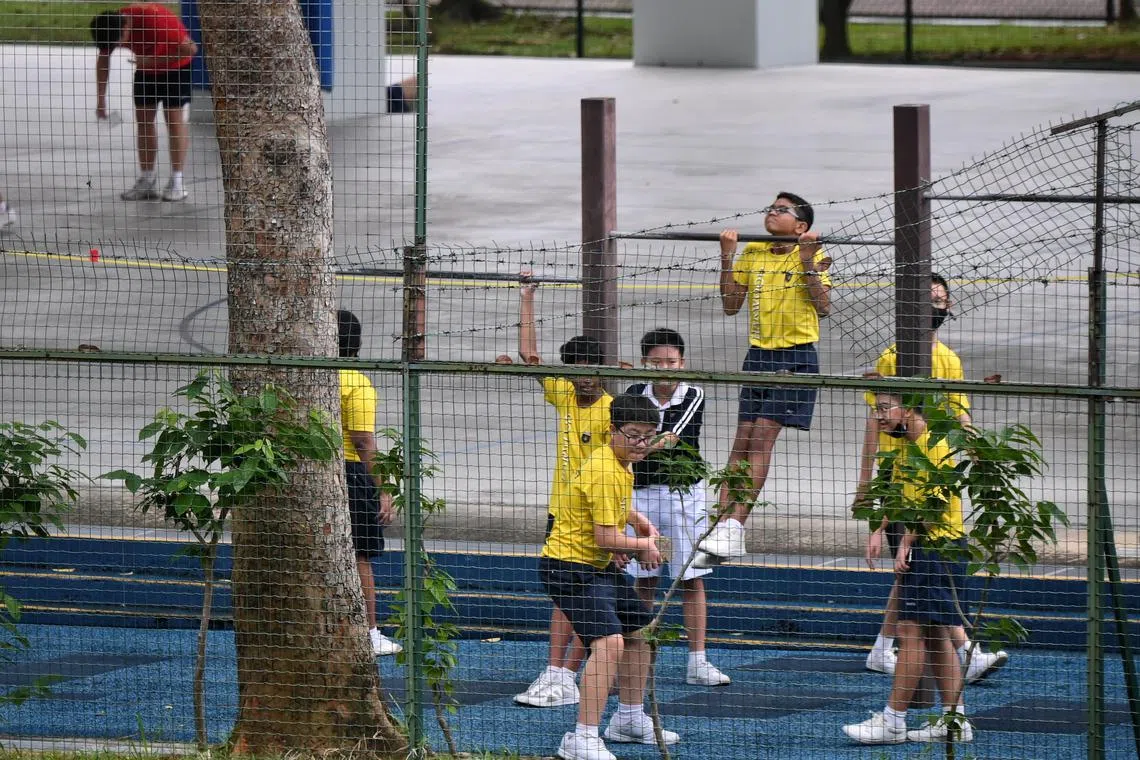Over half of kids, teens in S’pore do not hit physical activity targets: Study
Sign up now: Get tips on how to help your child succeed

In the long run, not being active can negatively affect children’s development, including mental well-being and social skills.
ST PHOTO: KUA CHEE SIONG
Follow topic:
SINGAPORE - Children and adolescents are not making full use of the spaces Singapore provides for physical activity and movement.
And though they are, on average, more active than their peers globally, more than half of them still fall short of hitting the recommended one hour of moderate to vigorous exercise per day, according to a newly published study.
A report by the Saw Swee Hock School of Public Health at the National University of Singapore (NUS) came to this conclusion after researchers analysed data on physical activity among children up to 18 years of age.
A total of 10 indicators were used, including participation in organised sports and active play.
Separate work groups compiled existing data for 57 countries – drawn from national surveys and large-scale studies, where possible, as well as scientific articles and reports – that was then reviewed by a global panel of experts.
Three local university academics and several representatives from the Health Promotion Board and Sport Singapore were also involved in the study.
The main data sources for Singapore included the National Sports Participation Survey and the Growing Up in Singapore Towards Healthy Outcomes cohort study, which were conducted before Covid-19.
The researchers took into account data released from July 2010 to July 2020 about children and adolescents up to 18 years of age in Singapore that could provide information about at least one of the 10 indicators.
The study, which was published in the Journal Of Exercise Science And Fitness in January, also looked at the role of family and peers in encouraging physical activity and wider societal support.
It is part of a larger project led by Active Healthy Kids Global Alliance, a Canadian non-profit organisation, which aims to promote healthier lifestyles among children and youth.
Singapore scored C- for overall physical activity – not quite meeting the global recommendation of at least 60 minutes on average of moderate to vigorous exercise per day.
The country was given an A+ for how well its community and environment supported physical activity, and a B for how much the Government promoted and implemented such opportunities.
In contrast, it got Bs and Cs for other aspects, like family support and sedentary behaviour.
In terms of overall scores, the 57 countries in the study received an average of D+. Finland and Japan emerged at the top with an average grade of B-.
Associate Professor Falk Muller-Riemenschneider, one of the researchers from NUS’ Saw Swee Hock School of Public Health behind the study, said: “We have a supportive environment and Government, but the behavioural indicators at this point in time are definitely not optimal.”
Another key takeaway was that there was limited or absent data available in Singapore, making it difficult to assess certain aspects of physical activity, he said.
The three other researchers involved in the study were Ms Zoey Tay, a research associate, Ms Chen Bozhi and Ms Kiran Yan Kui – the last two were formerly from the same school.
The global project also brought to light good practices across countries that Singapore could learn from, said Prof Falk.
Finland, for example, has a national research-based programme which promotes physical activity in schools and ensures children remain active throughout the day. More than 90 per cent of Finnish schools are part of the initiative.
Mrs Eva Chng, 37, who has a son and a daughter in primary school, said her children were much more active in their pre-school years, when every weekend was spent at parks or playgrounds.
“Now there is no incentive to go to parks to just walk, unless they are looking for a specific playground or an attraction to visit,” said the housewife.
“So I try to plan longer walking distances to the malls with the family and I schedule in daily exercise at home, with the children following exercise videos on YouTube for at least 20 minutes.”
She added: “The Government can provide equipment and places, but it also depends on the parents to take children out. Grandparents may be free during the day, but they are also not as physically able to chase the children outside.”

Dr Chan Poh Chong, head and senior consultant at the Division of General Ambulatory Paediatrics and Adolescent Medicine under the department of paediatrics at Khoo Teck Puat-National University Children’s Medical Institute at National University Hospital, said the motivation to exercise is lacking, despite access to safe parks, playgrounds and sports facilities.“Likely reasons include poor family support and encouragement for physical activities and an emphasis on academic success, as well as increased screen time allowed at home,” he said.
Dr Benny Loo, a consultant at KK Women’s and Children’s Hospital’s Sport and Exercise Medicine Service, said studies by the hospital suggest that parents do not know enough about the physical activities, screen time, eating habits and amount of sleep their children need in a day.
In 2021 and 2022, KKH launched 24-hour activity guidelines for children and adolescents,
In the long run, not being active can negatively affect children’s development, including mental well-being and social skills, said Dr Loo.
Parents are strongly encouraged to play with their children frequently, take them outdoors and allow them to learn various motor skills, he added.
Schools could provide small “movement breaks” in between sit-down lessons, to break up a prolonged sedentary period.
Dr Chan said families can also exercise and do activities like hikes, walks and cycling together, and schools could make sports co-curricular activities accessible to all students.


